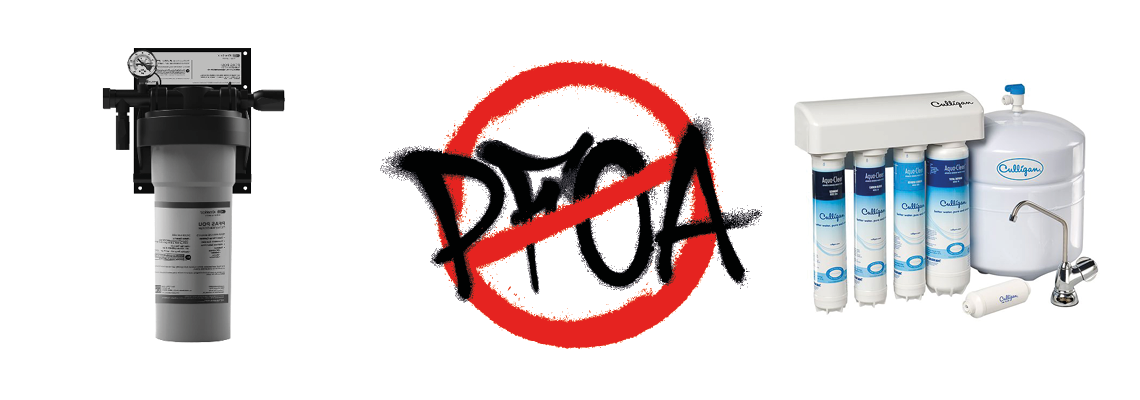Tech dive: the point of use systems taking on PFAS
With regulation playing catch up on Per- and Polyfluoroalkyl Substances (PFAS), otherwise known as “forever chemicals”, what role can point of use (PoU) systems play? As well as providing an extra layer of filtration against harmful contaminants, can technology developments drive national policy? Andrew Godfrey investigates.
Current national policy towards PFAS
Currently, in the US, there is a lack of federal policies that protect US citizens from the potential negative impact of PFAS.
On July 21, US Congress passed a bill for the Environmental Protection Agency (EPA) to enact limits on PFAS chemicals in drinking water and declare them hazardous substances.
President Joe Biden’s Environmental Justice Plan includes a commitment to set “enforceable limits for PFAS in the Safe Drinking Water Act." However, the EPA's Health Advisories address only applies to Perfluorooctanoic acid (PFOA) and Perfluorooctane sulfonate (PFOS).
As a result, many US states are proactively adopting their own broader and stricter requirements when it comes to regulating these chemicals.
“The EPA's Health Advisories address only applies to Perfluorooctanoic acid (PFOA) and Perfluorooctane sulfonate (PFOS).”
Speaking to Aquatech Online, Tom Bruursema, associate director of member & public engagement from Water Quality Association (WQA), said: "The adoption of American National Standards (NSF/ANSI) has provided the basis by which treatment technologies can be independently evaluated and certified to demonstrate performance, providing for the basis by which state and national policy can be established relative to PoU treatment solutions."
It would seem then that PoU systems are being viewed by some as a final barrier against PFAS chemicals in private water systems, including smaller community water systems.
Change is required for impact
The certification of PoU systems for PFAS is still in its infancy. With a limited range of certified products on the market, it raises the question of how much impact can they have?
From a policymaker's point of view, new policies and regulations will start by looking at the larger municipal systems first, with the effects of those policies trickling down to the small community systems and residential systems, including PoU systems.
On a national scale, we need the EPA to regulate PFAS contaminants by establishing maximum contaminant levels (MCL) and guidance levels for PFAS compounds.”
Speaking to Aquatech Online, Peter Meyers, senior technical director, and Marianne Metzger, laboratory sales executive of ResinTech, said: "On a national scale, we need the EPA to regulate PFAS contaminants by establishing maximum contaminant levels (MCL) and guidance levels for PFAS compounds.
"Until/unless that happens, the national policy will not drive PFAS regulation. It will continue to be driven by individual state regulations."
At the moment, certified treatment technologies are available and being applied to meet the existing demand in the absence of a national policy.
Raising public awareness
One of the key barriers to drive new regulations and policies is raising awareness of PFAS and the PoU systems that can prevent them.
What will be important to convey is that the PFAS challenge is not going away anytime soon. As the name – forever chemicals – suggest, they can be present in the environment, including water, for a very long time.
"We may take care of one harmful PFAS chemical only to find another one later due to their extensive use in the world,” said Dr Cang Li, director of product development/QC at Kinetico.
Speaking to Aquatech Online, he said: “PFAS contamination is similar to microbial contamination. It is hard for you to eliminate them."
The WQA currently provides and continues to educate the water treatment community about PFAS, the sources of contamination and the PoU options available to remove these chemicals from your water.
"We may take care of one harmful PFAS chemical only to find another one later due to their extensive use in the world.”
The association provides specific and specialised information on its industry website, with information to its dealer member network for distribution to the end-user - specifically on the availability of certified PoU devices.
A consumer website, BetterWaterToday.org, is also available and tailored to people wanting to know the basic information and available treatment solutions.
Main drivers of adoption
According to the WQA, the main drivers behind PoU devices as a treatment solution for PFAS can be attributed to broad media attention on the widespread contamination and health implications.
The rapid adoption of new national policies and standards for the evaluation and certification of technologies can also be seen as a key driver for the adoption of these PoU devices.
Another driver is the response from the PoU industry, with systems capable of delivering contaminant reduction to a high standard and reasonable price.
“California, which is one of the smallest allowable concentrations at 5.1 parts per trillion (ppt) and applies only to PFOA.
"Additional drivers would come from legislation and regulation specifically calling out PoU and point of entry (PoE) utilisation and acknowledgement as a treatment solution at the national level and by individual States," added the WQA’s Bruursema.
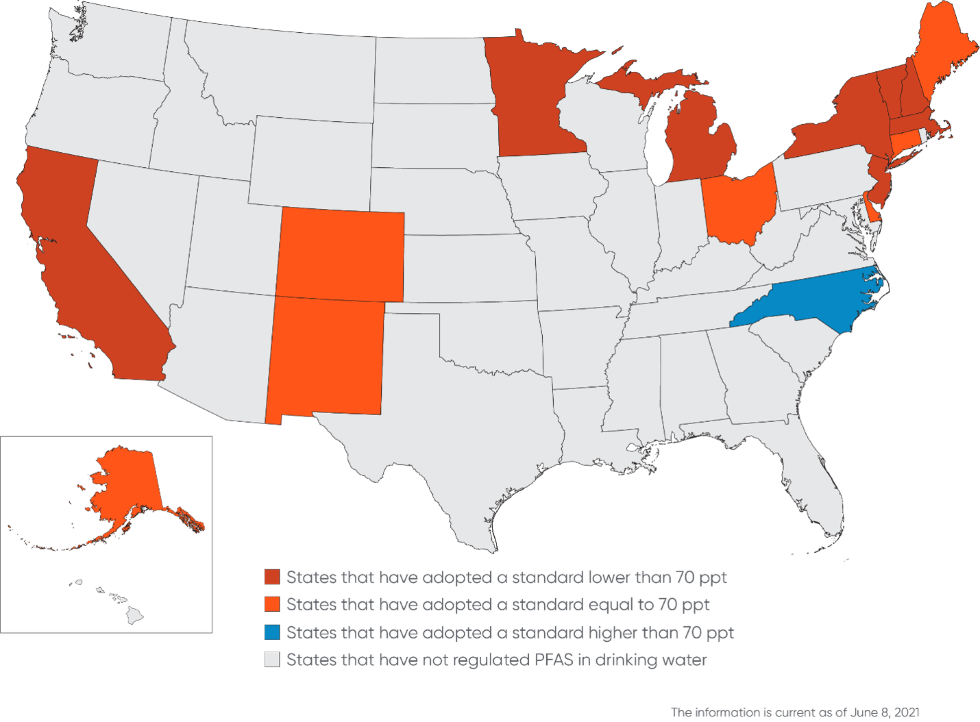
Source: jdsupra
Already some states consider POE/PoU systems to be viable alternatives to larger community water systems.
Currently, the regulatory landscape for PFAS compounds in drinking water consists of an array of widely varying state published standards and regulations.
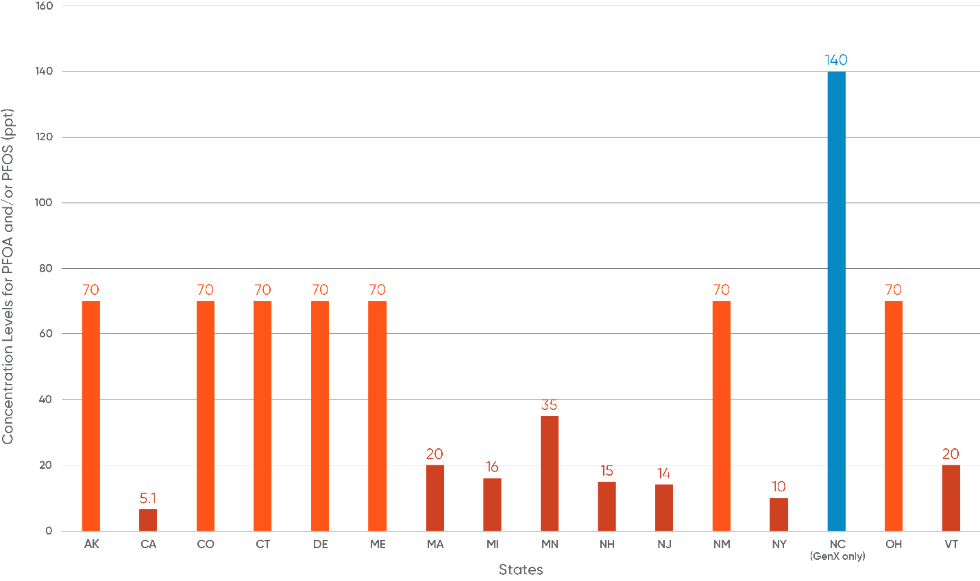
Source: jdsupra
California, for example, has one of the smallest allowable concentrations at 5.1 parts per trillion (ppt) and applies only to PFOA.
The Orange County Water District (OCWD) is undertaking North America’s largest PFAS pilot testing program. The district is currently working on adding 10 PFAS treatment plants throughout the area and has provided more than a year's worth of data to help determine the most effective treatment media to remove PFAS.
On the other end of the spectrum is Michigan, which has one of the largest values of 400,000 ppt.
As of June 8th 2020, the following states in the US have no PFAS regulations: Alabama, Arizona, Arkansas, Florida, Georgia, Hawaii, Idaho, Illinois, Indiana, Iowa, Kansas, Kentucky, Louisiana, Maryland, Mississippi, Missouri, Montana, Nebraska, Nevada, North Dakota, Oklahoma, Oregon, Pennsylvania, Rhode Island, South Carolina, South Dakota, Tennessee, Texas, Utah, Virginia, Washington, West Virginia, Wisconsin, and Wyoming.
Meet the PoU PFAS players
Multiple PoU systems now claim the ability to remove PFAS from water. We take a look at several solutions below.
Kinetico Water Filtration System - PFAS PoU

Source: Kinetico
The Kinetico PFAS PoU filter is designed for commercial and residential applications. The system has been tested according to NSF/ANSI Standard 42 and 53 for the reduction of chlorine, chloramine, particulate class one particles and PFOS and PFOA.
A carbon-based system, it features a quick-change cartridge. Kinetico says it is economical in its operational capacity and reduces tastes and odours in the water.
Cartridges need to be changed when the pressure drops below 30 psi or when the flow rate falls. The system has a capacity of 2,000 gallons (7,571 litres) and flows at 2.8 GPM (gallons per minute).
The filtration system has a PFOS and PFOA reduction rate of 95.3 per cent, according to the company.
Dr Cang Li told Aqautech, "This product has existed for ten years, and we are constantly improving it. Two years ago, we got the same certification for PFAS with a capacity of 5,000 gallons, 1.5 GPM. Now though, people want a higher flow, so we have increased the flow and reduced the capacity."
Culligan - Aqua-Cleer® Advanced Total Defence Water Filtration System
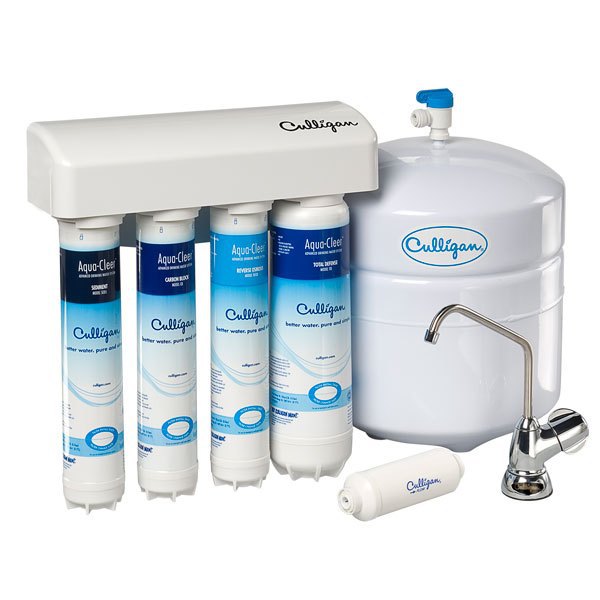
Source: Culligan Water
The Culligan Aqua-Cleer® Advanced Total Defense Cartridge uses a carbon filter to remove PFOS and PFOA, mercury, MTBE's (Methyl tertiary-butyl ether), and volatile organic chemicals.
The cartridge is fitted to the Aqua-Cleer Advanced Under Sink Water Filtration System and features electronic monitoring to ensure the PoU device is running properly and producing cleaner water.
Filtered water can then be connected to household appliances, including coffee machines or icemakers.
Brita - Total360 Reverse Osmosis Drinking Water Filtration System
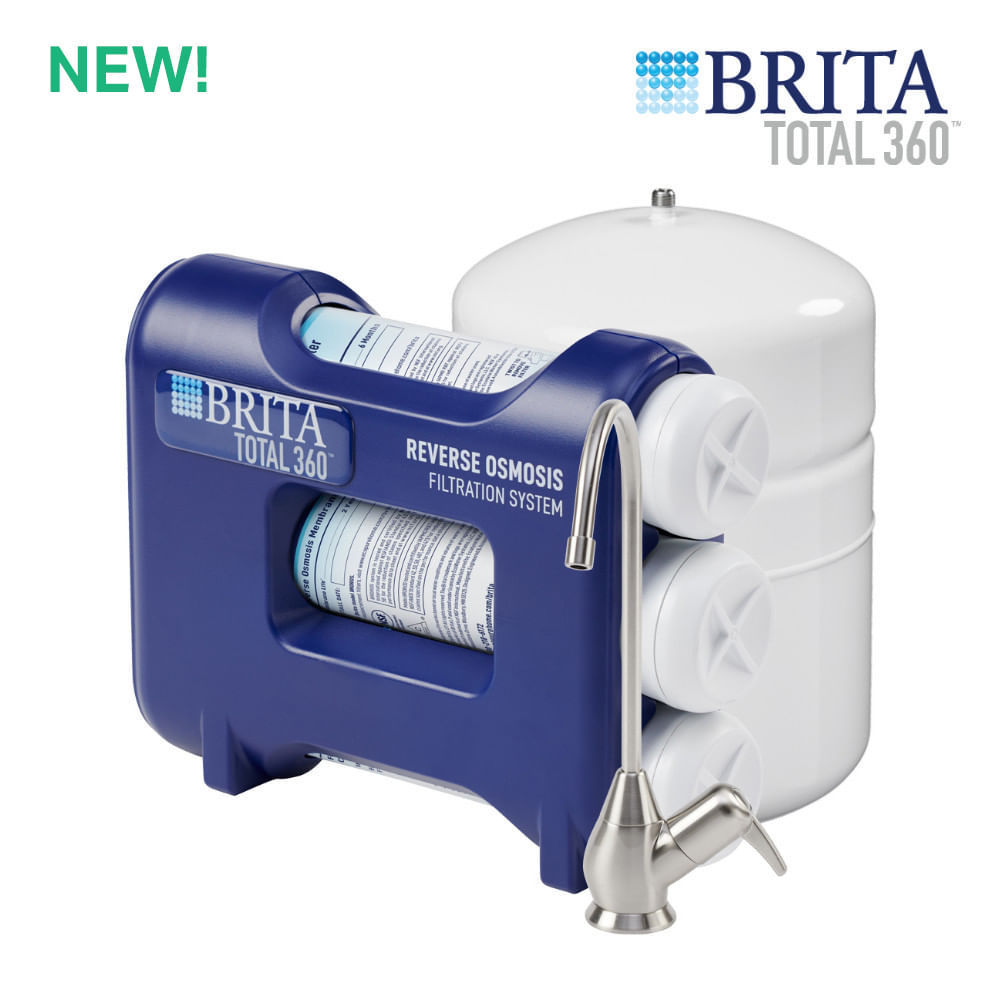
Source: Brita
The BRDROS Brita Total 360™ Reverse Osmosis Drinking Water Filtration System is an NSF International certified to reduce unsafe levels of more than 60 water contaminants, including lead, PFOAs, nitrates and chlorine taste and odour.
It offers a three-stage reverse osmosis system that is installed under the kitchen or bathroom sink and comes with a 'designer' brushed-nickel faucet.
Designed for simple maintenance, this RO system uses long-lasting, encapsulated filters that can be removed without the need to shut off the water supply.
The pre/post filter has a life of up to six months and a membrane life of up to two years. Brita says it reduces 99 per cent of lead, 97 per cent of PFOA/PFOS and up to 99 per cent of 60 plus common contaminants from drinking water.
With a capacity of 14.76 gallons, the system can be installed without the need for engineers.
ResinTech - PFAS Testing
ResinTech offers two analytical options for PFAS testing.
EPA 537.1: ResinTech will perform EPA 537.1 in drinking water for the list of PFAS substances that are EPA-approved by the method. EPA 537.1 is a prescriptive drinking water method for PFCs.
It can only be used for the compounds in drinking water samples and is limited in the allowable modifications, according to the method.
ASTM D7968-17: To support our customer's site investigation efforts, ResinTech performs the analysis of soil samples for PFAS using the analytical method ASTM D7968-17. The method, developed by the US EPA Region 5 Chicago Regional Laboratory, is an LC-MS-MS method specific for PFAS in soil. Soil samples are prepared for analysis with a solvent extraction prior to analysis.
Blockers for the future
In addition to the presently studied PFAS chemicals, one of the biggest challenges is the additional chemicals being found that need to be researched.
According to the WQA, the EPA fifth Unregulated Contaminant Monitoring Rule (UCMR 5) includes 29 chemicals, and PoU systems must be tested to determine how well these new chemicals can be reduced.
“PFAS removal by either carbon or resin requires significant empty bed contact time (EBCT), which PoU systems typically do not provide due to their smaller size.”
The main challenge to solving this will be to introduce national regulations to adapt requirements across the country, rather than having varying requirements at a state level.
"PFAS removal by either carbon or resin requires significant empty bed contact time (EBCT), which PoU systems typically do not provide due to their smaller size," added Meyers and Metzger from ResinTech.
They added: "While there is voluminous data on the dangers of ingesting PFAS, there is little data on the adsorption through our skin, and PoU does not address water that we use for showering, so technologies like carbon and IX resins will become more important as POE systems."
What needs to happen next?
The PoU industry has brought effective solutions to address PFAS contamination, with more developments on the way.
The next step will be the alignment of state and national policy with the recognition and application of PoU treatment technology solutions in order to accelerate their use.
The WQA believes that existing American National Standards should also be updated to include a greater number of chemicals. When appropriate, a surrogate chemical could be introduced to represent the broad category for more efficient, cost-effective testing of PoU devices and central treatment at a community level.
The PFAS challenge isn’t going away anytime soon. While policy at a national level continues to be ironed out, PoU solutions could be one valuable tool to help bolster treatment across the entire water cycle.
Related content
- PFAS certification in the US: the lay of the land
- Jason Dadakis on OCWD’s PFAS removal pilot
- Tech dive: the future of point of use systems
Share your water technology stories with us
Do you have an innovation, research results or an other interesting topic you would like to share with the international water technology industry? The Aquatech website and social media channels are a great platform to showcase your stories!
Please contact our Sr Brand Marketing Manager Annelie Koomen.
Are you an Aquatech exhibitor?
Make sure you add your latest press releases to your Company Profile in the Exhibitor Portal for free exposure.
We promise never to send you spam and you can unsubscribe at any time!

